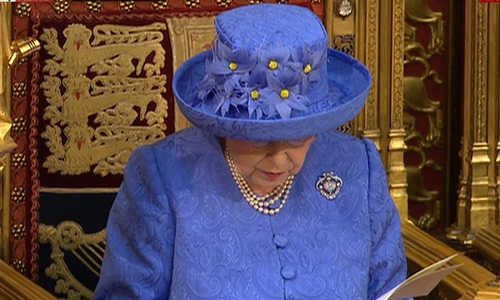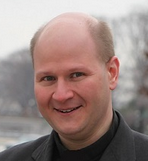
This morning, Queen Elizabeth II opened a new session of the UK Parliament by delivering her 64th “Queen’s Speech.” This event, which contains ceremonial elements dating back centuries, lays out the government’s vision for the upcoming legislative session. The 2017 Queen’s Speech focused primarily on Brexit and enhancing trade with the rest of the world, as well as terrorism, the Paris climate agreement, and NHS funding. This year’s speech differed from previous years in a number of ways, notably its delayed scheduling, its reduced ceremonial pomp, and the fact that it will usher in a two-year-long session of Parliament.
What is the Queen’s Speech?
The Queen’s Speech is the formal beginning of Parliament. This event involves all three constituent elements of Parliament: The Sovereign (King or Queen), the House of Lords, and the House of Commons; members of the judiciary and the Church of England, as well as invited guests, are also traditionally present. From a throne in the House of Lords, the queen reads a speech written by the government that details its legislative agenda for Parliament in the upcoming year or session.
What are the ceremonial elements associated with a typical Queen’s Speech?
The Sovereign usually rides in a horse-drawn carriage, escorted by the Household Cavalry, approximately one mile from Buckingham Palace to Parliament in Westminster. Wearing the crown and the Robe of State, with its long, dark red velvet train, she leads a procession to take her place at a throne in the House of Lords. At that time a senior official in the House of Lords, known as the Gentleman Usher of the Black Rod (usually shortened to “Black Rod”), walks to the House of Commons to summon the lower chamber to the speech. Lieutenant General David Leakey has served as Black Rod since 2010; the office was instituted in 1350.
When he arrives, the door is slammed in his face – a tradition dating back to the English Civil War, symbolizing Parliament’s independence from the monarchy. Black Rod then raps upon the door three times, the doors are opened and MPs, led by the prime minister and the shadow cabinet, process to the House of Lords.
The Lord Chancellor keeps possession of the speech until he hands it to the Sovereign. Until recently, the text was inscribed on vellum, an exquisite parchment made from calf’s skin, but is now written on goatskin parchment (which contains no actual goatskin). The queen returns it to him after it has been read. Following the speech, both houses of Parliament meet and draft an “Address in Reply to Her Majesty’s Gracious Speech.”
Queen Elizabeth II has only failed to deliver the speech in person twice, in 1959 and 1963, due to pregnancy. In each case, the Lord Chancellor read it in her place.
How was the 2017 Queen’s Speech different from previous years?
The 2017 Queen’s Speech stood out in comparison with prior years in three ways:
- The prime minister delayed the speech by two days. PM Theresa May moved the Queen’s Speech, originally scheduled for Monday, to this morning reflecting uncertainty that her Conservative Party would be able to strike a governing arrangement with Northern Ireland’s Democratic Unionist Party (DUP). The Conservative Party lost its slim majority following the June 8 snap elections, and negotiations to hammer out a confidence and supply arrangement with the DUP haven dragged on longer than anticipated. Failure to secure a vote on the Queen’s Speech could have triggered a no confidence vote and another national election.
- The 2017 Queen’s Speech omitted traditional ceremonial elements. A number of accoutrements of royal pomp and circumstance were missing from this year’s speech. The queen arrived by car rather than by carriage. She made no royal procession to the House of Lords, and she wore a hat and “day dress” rather than her crown and Robe of State. Prince Philip, 96, was absent this year after being admitted to King Edward VIII Hospital due to an infection caused by a preexisting condition. The queen was instead accompanied by her son, Prince Charles.
- There will be no Queen’s Speech in 2018, as this year begins a rare two-year-long session of Parliament. The prime minister’s office announced last week that “Parliament will sit for two years, instead of the usual one, to give MPs enough time to fully consider the laws required to make Britain ready for Brexit.” This is only the third biennual Parliament since 1949. The last took place in 2010, as David Cameron’s Conservative Party struck an unsteady coalition government with the Liberal Democratic Party led by Nick Clegg. Critics say the term is designed to help May cling to power; Tory officials say the two-year Parliament was planned before the snap election was called.
What policies did Queen Elizabeth II announce in the 2017 Queen’s Speech?
The speech, which began at 11:30 a.m. London time, focused largely on Brexit. It featured Theresa May’s characteristic phrases, such as providing “stability” and securing “the best possible deal” from the European Union. Among the most significant policies contained in the 27 bills referenced were:
Brexit and EU regulation. Eight of the 27 bills mentioned this morning related to the UK’s exit from the European Union. Parliament will vote to repeal the 1972 European Communities Act, which cemented the UK’s membership in what became the EU. The queen also referred to the Great Repeal Bill, which will transpose the full body, or “acquis,” of EU regulations into UK law.
Future free trade deals, global development, and low taxes. The queen said, “My government will seek to maintain a deep and special partnership with European allies and to forge new trading relationships across the globe.” This echoes May’s vision of expanding free trade, especially with the developing world, since the UK will no longer have to impose high tariffs on imported agricultural goods. This may well stimulate commerce and reduce poverty in underdeveloped nations. The speech promised to spend 0.7 percent of national income on international development to “project British values around the world,” while “keeping taxes low.”
Paris climate agreement. The queen vowed to “support international action against climate change, including the implementation of the Paris Agreement.” Critics say the agreement, which President Trump has opposed, will hamper Western economic growth while doing little to improve the environment.
Additional spending and minimum wage increases. The speech signaled May’s goal of generating “tax revenues needed to invest in the National Health Service.” The British Red Cross has accused the perpetually imperiled NHS of creating a “humanitarian crisis” through a combination of long waits, overcrowding, and understaffed facilities. Increasing NHS funding is a top DUP demand. The Queen’s Speech also vowed to increase the UK’s national living wage, which the Institute of Economic Affairs warns will cost “thousands of jobs.” The queen promised action to “tackle the gender pay gap”; to fight discrimination based on “race, faith, gender, disability or sexual orientation”; and to eliminate “unfair” tenant fees.
Security and privacy reforms. In the wake of a wave of terrorist “incidents” sweeping the UK, the government has indicated it will crack down on online extremism. It also backs a Data Protection bill that secures greater online privacy, and provisions to allow greater flexibility in serving in the armed forces.
Does this speech put other issues off the table?
The Queen’s speech added, “Other measures will be laid before you.” The phrase is a hallmark of such orations, allowing the government to introduce additional policies not delineated in the speech. Among the issues most notably missing from the speech were:
Social care reform. The queen did not mention the more controversial aspects of the Conservative Party’s manifesto, such as the so-called “dementia tax,” ending universal “free” school lunches for the youngest school children, and means-testing home heating assistance. Tories blame May’s rollout of such policies for their electoral setback.
Immigration. The queen pledged to “establish new national policies on immigration”; however, the Tories’ pledge to reduce immigration to “tens of thousands” a year was conspicuously absent.
President Donald Trump’s visit and the U.S-UK special relationship. The Queen’s Speech made no mention of President Donald Trump making a state visit to the UK. There is a silver lining for the president, though: The queen promised to meet the NATO commitment to spend at least two percent of GDP on defense, a measure he forcefully and publicly advocated during the G-7 and NATO summits last month.
Was there a religious element to her speech?
Queen Elizabeth II concluded her speech by saying, “I pray that the blessing of Almighty God may rest upon your counsels.”
You can read the full text of her speech here.
(Photo: Screenshot of the 2017 Queen’s Speech.)

